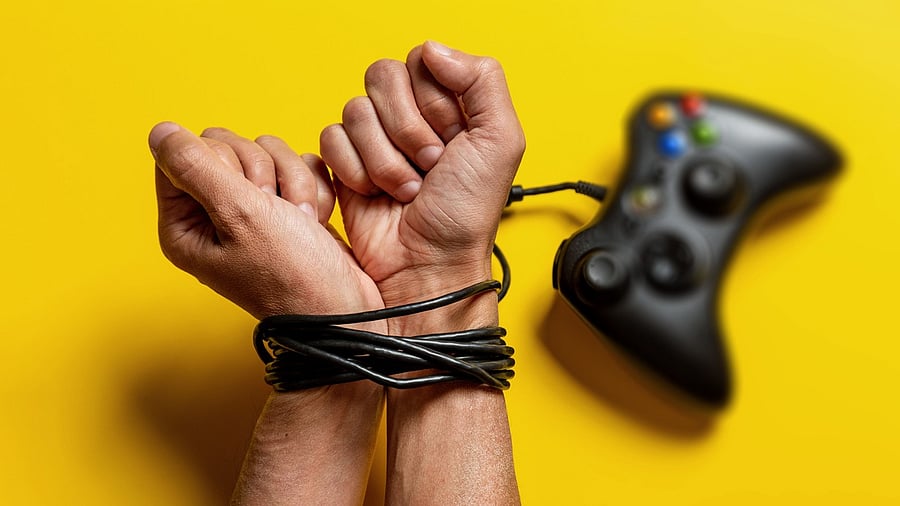
Representative image of gaming addiction.
Credit: iStock Photo
Technology has become a fundamental aspect of our daily lives. While responsible technology use enhances one’s cognitive skills and has made many human activities easier, the omnipresence of technology has paved the way to a pressing issue: technology addiction. Often referred to as internet addiction or digital addiction, this is characterised by the excessive use of screen media for a large amount of time to the extent that the individuals lose control over their usage, adversely affecting their personal, social and occupational lives. While technology expands its landscape rapidly, it has become important for everyone to understand and address this issue.
John, a 17-year-old student, started spending hours playing online games during the pandemic. What began as a way to relieve boredom soon escalated to 10-12 hours of daily gaming, causing him to skip meals, lose sleep, and neglect schoolwork. His relationships with family and friends deteriorated, and despite repeated attempts to cut back, he found himself unable to stop. John’s parents noticed significant mood swings and irritability when he wasn’t playing, prompting them to seek professional help. John’s is not an isolated cas.
Excessive use of technology is detrimental to mental and physical health and the overall well-being of the user. Physical health may deteriorate due to a sedentary lifestyle, leading to problems such as obesity, pain in various parts of the body, insomnia, and eye strain. In children and adolescents, technology addiction may affect cognitive development and social skills, limiting face-to-face interaction and creativity and can result in academic decline and behavioural issues. Excessive technology use can disrupt daily functioning, jeopardising personal relationships, and reduce motivation for offline activities, which reinforces a cycle of dependency and, over time, may worsen overall well-being.
The symptoms of technology addiction, like alcohol or drug addiction, involve excessive preoccupation with online activities, inability to control over-usage despite continued efforts, need to engage in it with increasing amounts of time to gain the same satisfaction as before, neglect of personal commitments, social withdrawal, restlessness or irritability when not engaged in the online activity, and lying about the overuse. Technology addiction can include addiction to a wide variety of online activities that can overlap or occur independently such
as gaming, binge-watching, online gambling, compulsive texting, social networking, and pornography.
Particularly at risk are children and adolescents. This can be attributed to inconsistent monitoring. People who experience high levels of stress can engage in excessive use of digital devices to cope with it. Moreover, boredom, loneliness, lack of social skills, poor self-esteem, family conflicts, and peer influence can lead to dependency on technology. Personality factors like high impulsivity are also linked to addictive behaviour. Individuals with neurodevelopmental disorders such as attention-deficit hyperactivity disorder and various mental health disorders such as anxiety, depression, and alcohol or drug addictions may turn to the internet as a way to cope with their difficulties.
The 5C approach
Given its impacts and consequences, it is essential to assess an individual’s risk for addiction and implement effective management strategies before it escalates. Assessing our screen use with the 5Cs – Craving, Control, Coping, Compulsion, and Consequences, helps determine if it is balanced or excessive. This approach encourages reflecting on whether an individual has excessive drive to engage in online activities, whether screen time is within one’s control, whether it helps in coping, whether there is compulsive or excessive use and how it impacts daily life. If an individual has four of the above Cs, he/she may likely have a technology addiction.
Total abstinence from digital devices is impractical, given their utility in daily life. A balanced approach – using technology to promote well-being without letting it dominate – is recommended. Practising digital hygiene – by managing screen time, maintaining privacy, avoiding over-reliance, establishing tech-free zones at home, engaging in offline activities and social interactions, preventing digital distractions and using technology mindfully – fosters healthier relationships with technology and promotes mental well-being.
Incorporating digital fasting, or taking intentional breaks from screens, can further reset our relationship with technology. Additionally, building digital literacy equips individuals with the knowledge to navigate technology responsibly, understanding its potential risks such as privacy issues, cyberbullying etc and practising digital nutrition encourages mindful consumption of quality content that supports mental and emotional health. For individuals struggling to control their technology use, professional help may be essential. Interventions like cognitive-behavioural therapy, supportive psychotherapy, and family therapy can address the root causes and help restore balanced usage.
(Manoj is a professor, and coordinator of SHUT Clinic, NIMHANS; Ahsana is a PhD scholar in the Department of Clinical Psychology, NIMHANS. This is the eighth article in a DH-NIMHANS series on mental health)